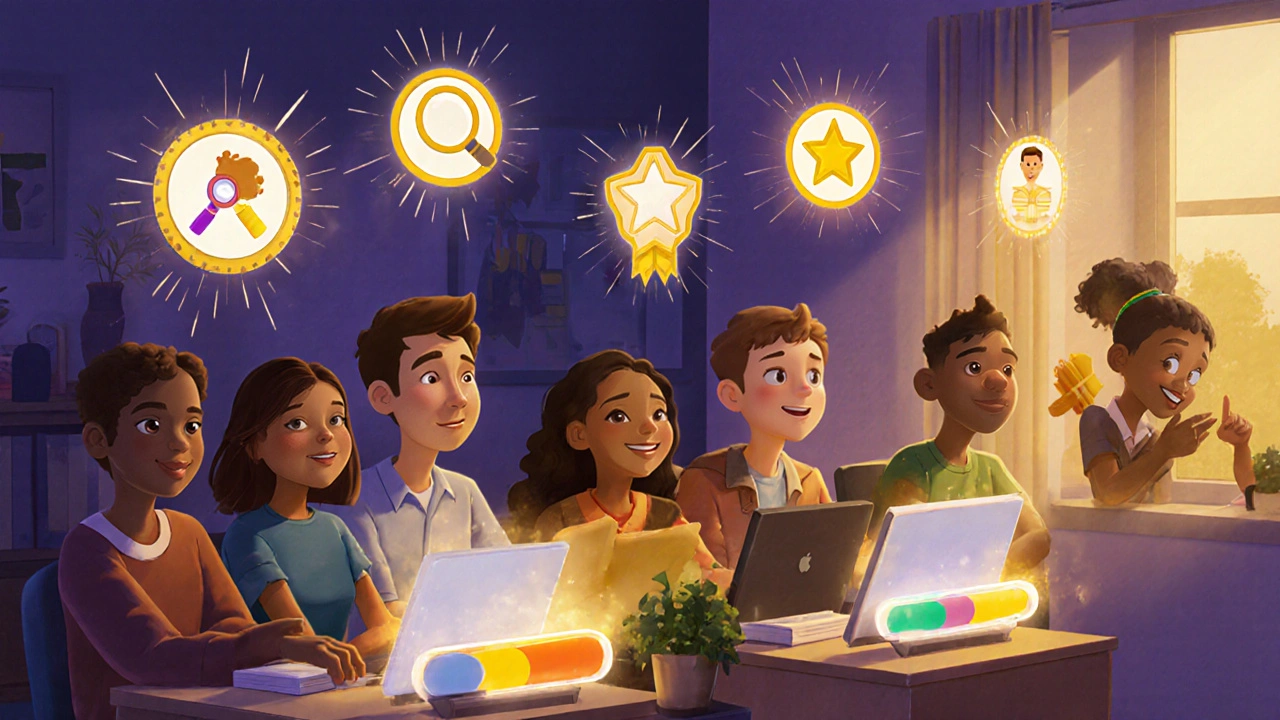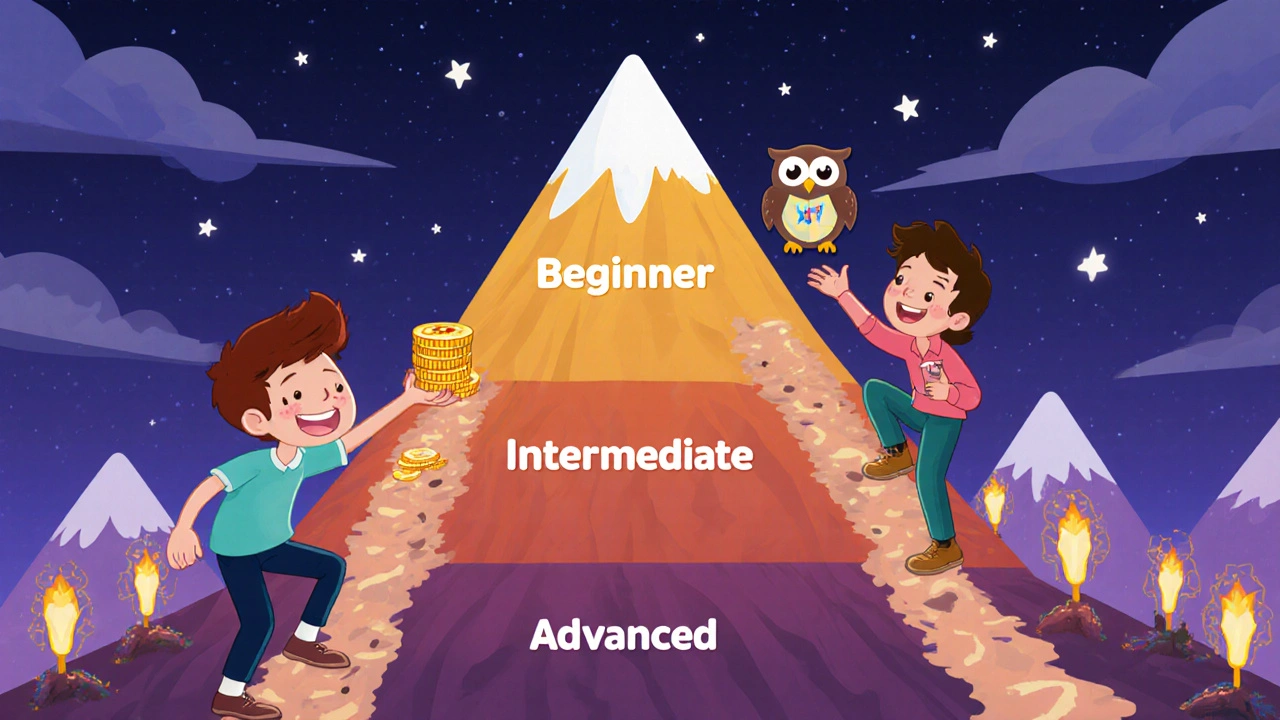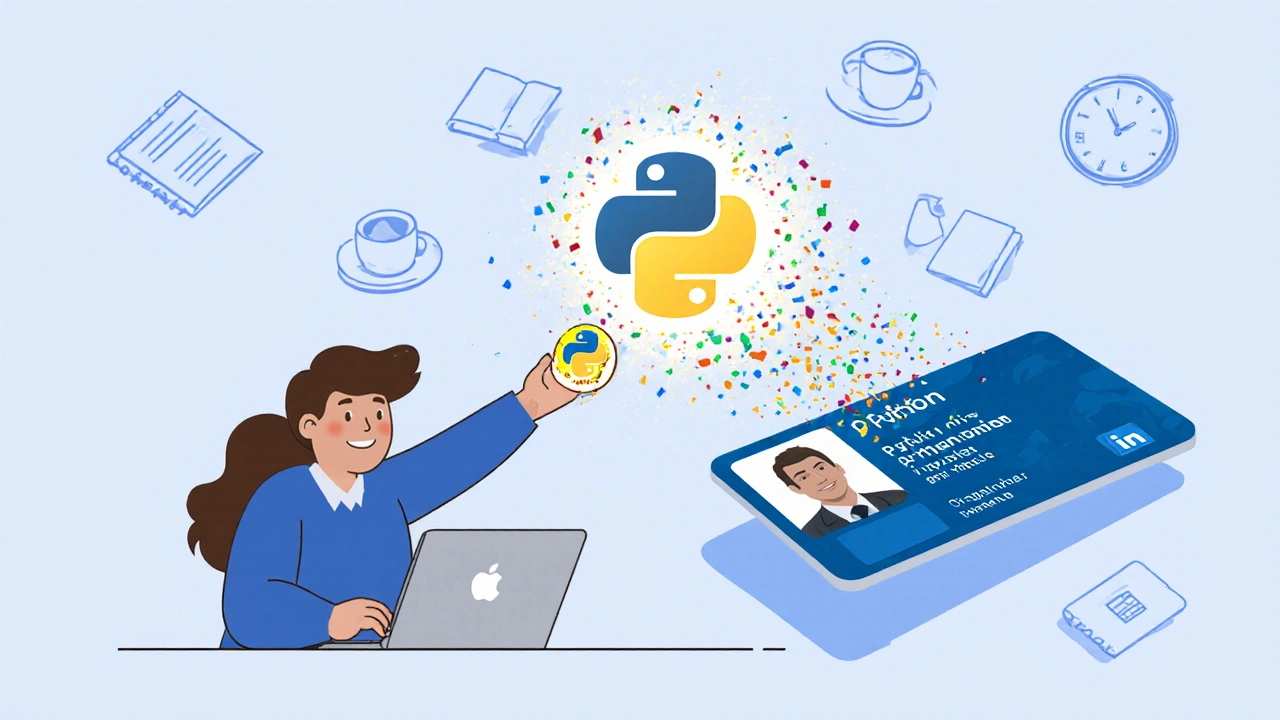Gamification in Online Courses: How Badges, Points, and Leaderboards Boost Engagement
 Sep, 9 2025
Sep, 9 2025
Ever finished an online course just because you wanted that final badge? You’re not alone. Millions of learners log in daily not just for the content, but for the dopamine hit of earning points, climbing a leaderboard, or unlocking a new achievement. Gamification isn’t just a trend-it’s a proven way to turn passive viewers into active participants. And when done right, it doesn’t feel like a game. It feels like progress.
Why Gamification Works in Online Learning
Online courses have a big problem: dropout rates. Studies show that over 80% of people who start an online course never finish it. Why? Because learning alone, without feedback or social pressure, is hard. Our brains are wired for rewards, competition, and clear progress markers. Gamification taps into that.
Think about it. When you play a mobile game, you don’t just tap randomly. You know exactly what to do next because you get a visual cue-a flashing icon, a sound, a new level. Online courses rarely give you that. But when you add a progress bar that fills up as you complete modules, or a badge that pops up after you pass a quiz, your brain says: “I did that. I want more.”
Research from the University of Colorado found that learners in gamified courses completed 34% more content than those in traditional courses. Not because the material was easier. Because the system made them feel like they were winning.
Badges: More Than Just Digital Stickers
Badges are the most common gamification tool in online learning. But most courses use them wrong. They hand out badges for logging in, or for watching a 5-minute video. That’s not motivation-it’s noise.
Effective badges are meaningful. They represent real skill acquisition. For example:
- “Data Detective” - earned after correctly analyzing a real dataset in a business analytics course
- “Python Ninja” - unlocked only after building a working script from scratch
- “Peer Mentor” - awarded to learners who help others in discussion forums with high-quality responses
These badges aren’t just visual rewards. They’re proof of competence. Learners start sharing them on LinkedIn. Employers begin asking about them during interviews. Suddenly, a badge isn’t a trophy-it’s a credential.
Platforms like Coursera and Udemy now let learners export badges as digital credentials tied to blockchain-backed verification. That’s not gamification. That’s validation.
Points: The Hidden Engine of Consistency
Points are the quiet workhorse of gamification. They don’t get the spotlight like leaderboards, but they’re what keep learners coming back day after day.
The key? Make points tied to effort, not just completion. For example:
- 10 points for watching a video
- 25 points for completing a quiz with 90%+ score
- 50 points for submitting a project
- 10 bonus points for reviewing a peer’s work
That’s not arbitrary. It’s behavioral design. You’re rewarding depth, not just time spent. A learner who skips videos but nails the final project still earns more than someone who watches everything but fails the test.
Points also create a sense of accumulation. People don’t just want to earn-they want to collect. That’s why some platforms let learners spend points on perks: early access to new modules, one-on-one coaching sessions, or even physical merchandise like T-shirts or notebooks. It turns learning into a tangible economy.

Leaderboards: The Double-Edged Sword
Leaderboards are powerful. They create urgency. They spark competition. But they also scare people off.
Imagine you’re a beginner in a coding course. You see a leaderboard with people who’ve earned 12,000 points. You’ve earned 45. You feel defeated before you even start. That’s not motivation-that’s discouragement.
Smart leaderboards avoid this. They use tiered rankings:
- Class Leaderboard - only shows people in your cohort (50 learners max)
- Group Leaderboard - groups learners by skill level: Beginner, Intermediate, Advanced
- Personal Progress Graph - your own trajectory over time, not compared to others
Some platforms, like Duolingo, hide the global leaderboard entirely and only show your daily streak. That’s genius. It focuses on consistency, not comparison.
Leaderboards work best when they’re optional. Don’t force learners into public rankings. Let them opt in. And always give a “hidden mode” for those who just want to learn without pressure.
Putting It All Together: Real Examples That Work
Here’s what successful gamification looks like in practice:
Khan Academy uses points and badges to track mastery. You don’t just watch a video-you have to solve 5 problems in a row correctly to unlock the next level. That’s skill-based progression, not time-based.
Codecademy gives you XP for each completed exercise. You earn “Levels” as you accumulate XP. By Level 10, you’ve built 3 real projects. The system doesn’t just track your clicks-it tracks your output.
LinkedIn Learning lets you earn course badges that auto-post to your profile. That’s gamification with a professional payoff. You’re not just learning-you’re building your resume.
These aren’t gimmicks. They’re systems designed around how people actually learn: through small wins, visible progress, and social recognition.
What Not to Do
Bad gamification feels like a scam. Here’s what to avoid:
- **Giving points for watching ads** - learners notice. They feel manipulated.
- **Leaderboards with no context** - showing raw scores without explaining how they’re calculated breeds distrust.
- **Overloading with badges** - if every action earns a badge, none of them mean anything.
- **Forcing competition** - not everyone thrives on rivalry. Some learners need quiet, personal progress.
Gamification should feel like a helpful coach, not a drill sergeant.

How to Start Adding Gamification to Your Course
If you’re an instructor or course creator, here’s how to begin:
- Identify the key behaviors you want to encourage - completion? Practice? Peer help? Discussion participation?
- Match each behavior to a reward - badge for peer reviews, points for project submissions, progress bar for module completion.
- Keep it simple - start with one badge, one points system, and one optional leaderboard.
- Test with a small group - ask learners: “What made you keep going?” Then tweak.
- Make rewards meaningful - let learners use points for real benefits: certificate upgrades, extended access, or direct feedback from instructors.
You don’t need fancy software. Many LMS platforms like Teachable, Thinkific, and Moodle have built-in gamification tools. Start small. Measure impact. Scale what works.
The Future Is Personalized Gamification
The next wave isn’t just badges and points. It’s adaptive gamification.
Imagine a course that notices you’re stuck on Python loops. It unlocks a special “Loop Master” badge and gives you a mini-challenge with hints. Or it sees you’re a night owl and sends you a bonus quiz at 11 PM with extra points.
AI is making this possible. Platforms are starting to track not just what you do, but how you do it. Slow, careful learners get different rewards than fast, confident ones. That’s not one-size-fits-all. That’s respect.
Gamification isn’t about making learning fun. It’s about making learning feel worth it.
Do badges really help people finish courses?
Yes. A 2024 study by the Learning Technologies Group found that learners who earned at least three meaningful badges in a course were 2.3 times more likely to complete it than those who didn’t. The key is relevance-badges tied to actual skills, not just activity.
Are leaderboards bad for beginners?
They can be, if they’re global and unfiltered. But when leaderboards are limited to your cohort or skill level, they become motivating-not intimidating. The best systems let users toggle between public and private views.
Can gamification work for adult learners?
Absolutely. Adult learners respond even more strongly to gamification when rewards connect to real-world outcomes-like professional certifications, LinkedIn badges, or access to job boards. They’re not playing a game. They’re investing in their career.
How much does it cost to add gamification to a course?
It can be free. Many platforms like Moodle and Teachable include basic gamification tools at no extra cost. You just need to design the rules: what earns points, what unlocks badges. The real cost is time-not money.
Is gamification just for younger learners?
No. Gamification works for all ages because it taps into universal human psychology-progress, recognition, and reward. A 55-year-old professional taking a cybersecurity course is just as motivated by a “Security Expert” badge as a 20-year-old student is by a “Code Ninja” title.
Next Steps: Try This Today
If you’re taking an online course right now, look for the badge system. What does it reward? Is it meaningful? If not, give feedback to the instructor.
If you’re teaching one, pick one module and add a single badge for completing a practical task. Track completion rates before and after. You might be surprised how much a small reward changes behavior.
Gamification isn’t about adding games to learning. It’s about making learning feel like a journey where every step counts.
Andrew Nashaat
October 30, 2025 AT 08:32Okay but let’s be real-most of these ‘badges’ are just dopamine traps disguised as education. I’ve seen courses hand out ‘Completed Module 1’ badges like they’re candy at a parade. That’s not gamification, that’s manipulation. If your badge doesn’t require actual skill, it’s just a sticker on a cereal box.
And don’t get me started on leaderboards. You think a 45-year-old mom juggling three jobs wants to see some 22-year-old coding prodigy with 12k points? No. She wants to finish. Without shame. Without being made to feel like a failure because she’s not ‘competitive’ enough.
Real gamification? It’s invisible. It’s the quiet satisfaction of finally understanding a concept you’ve struggled with for weeks. Not a flashing icon. Not a leaderboard. Just… progress. That’s it.
Gina Grub
October 30, 2025 AT 22:06Nathan Jimerson
October 31, 2025 AT 12:16This is exactly why I keep going back to online courses. I don’t care about being #1 on the board. But when I earn a badge after building my first Python script-after failing three times-it feels real. Like I actually did something. Not just watched videos. Not just clicked through.
That badge? I saved it. I showed my boss. He asked me about it in our next 1:1. That’s the power here-not the game. The proof.
Sandy Pan
November 2, 2025 AT 11:07What we’re really talking about here isn’t gamification-it’s behavioral conditioning. Skinner’s box, but with certificates.
The brain doesn’t care if the reward is digital or physical. It cares about pattern recognition, anticipation, and reinforcement. Badges? They’re Pavlov’s bells for the modern learner. Leaderboards? They’re social validation loops. Points? They’re the currency of perceived effort.
The real question isn’t whether it works-it’s whether we’re okay with turning education into a reward economy. Because if we are, then we’ve already lost the higher purpose of learning. We’re not cultivating curiosity. We’re training compliance.
Eric Etienne
November 3, 2025 AT 19:23Dylan Rodriquez
November 5, 2025 AT 10:42I’ve seen both sides. I’ve taken courses where badges felt meaningless. And I’ve taken ones where earning a ‘Data Detective’ badge actually got me noticed by a hiring manager.
The difference? Intent. When gamification is designed to reinforce learning-not just activity-it transforms. It’s not about tricking people into clicking. It’s about honoring their effort with recognition that matters.
And yes-it works for adults. Maybe even more. We don’t need glitter. We need credibility. A badge that says ‘you can do this’? That’s not a game. That’s a lifeline.
Amanda Ablan
November 6, 2025 AT 19:37Just wanted to say-I love how this post breaks down what works and what doesn’t. So many platforms get it wrong by overloading with badges and forcing leaderboards. But the examples here? Khan Academy, Codecademy? Those are the gold standard.
And I appreciate the note about ‘hidden mode’ for leaderboards. That’s the kind of thoughtful design that says: we see you. We know not everyone thrives under pressure. That’s respect. That’s human.
Meredith Howard
November 8, 2025 AT 13:59Yashwanth Gouravajjula
November 9, 2025 AT 13:09Kevin Hagerty
November 10, 2025 AT 21:47Janiss McCamish
November 12, 2025 AT 13:43Richard H
November 13, 2025 AT 21:37Kendall Storey
November 14, 2025 AT 09:14I used to hate gamification. Thought it was childish. Then I took a cybersecurity course that gave me XP for each lab I passed. I didn’t even notice I was grinding. I just kept going. Why? Because each level felt like a win.
And when I hit Level 15? I got a custom certificate with my name on it. I printed it. Framed it. My wife said I was weird. I said: ‘You don’t understand. I didn’t just learn. I earned.’
Ashton Strong
November 14, 2025 AT 13:05Thank you for this comprehensive and well-researched analysis. The distinction between meaningful gamification and superficial reward systems is critical. Educators must prioritize pedagogical integrity over engagement metrics. When rewards align with mastery, not activity, we elevate learning from transactional to transformational. I commend the emphasis on personal progress graphs and opt-in leaderboards-these are not features. They are ethical imperatives.
Steven Hanton
November 14, 2025 AT 23:33I think the key insight here is that gamification works best when it’s invisible. The learner doesn’t think, ‘I’m doing this for the badge.’ They think, ‘I’m doing this because I want to get better.’ The system just makes that journey feel less lonely, less abstract.
That’s why the ‘Peer Mentor’ badge is so powerful. It doesn’t just reward skill-it rewards community. And that’s the real magic. Not points. Not badges. Connection.
Pamela Tanner
November 15, 2025 AT 07:38Kristina Kalolo
November 16, 2025 AT 20:37ravi kumar
November 18, 2025 AT 01:25Andrew Nashaat
November 18, 2025 AT 19:14Wait-so you’re telling me a 55-year-old in Ohio cares about a ‘Security Expert’ badge? I don’t think so. That’s just marketing fluff. People finish courses because they need the skills. Not because they want to flex on LinkedIn.
And if you think a blockchain-backed badge means anything to a hiring manager outside Silicon Valley, you’re delusional. Most employers still want a degree. Or a portfolio. Or a conversation. Not a digital sticker.
Stop selling snake oil. Gamification isn’t the future. It’s a Band-Aid on a broken system.